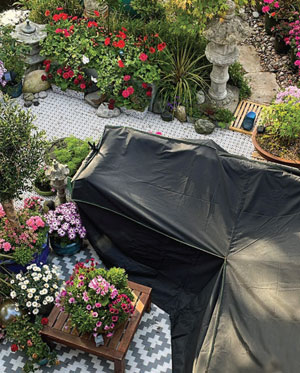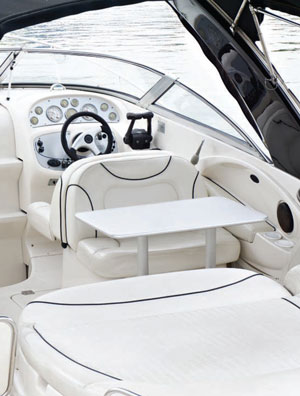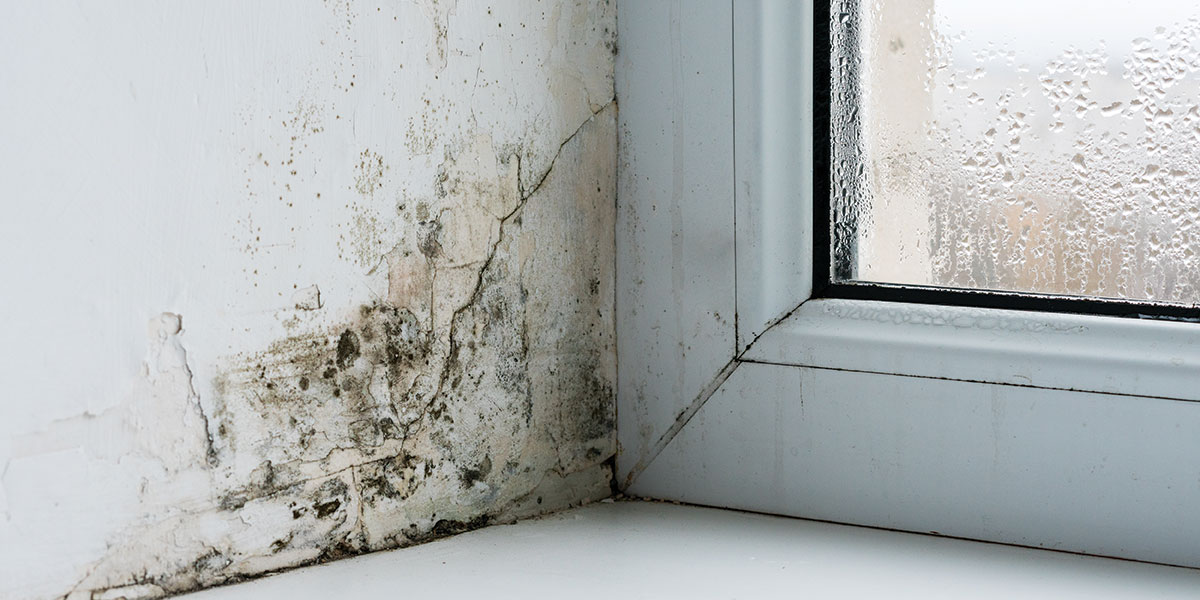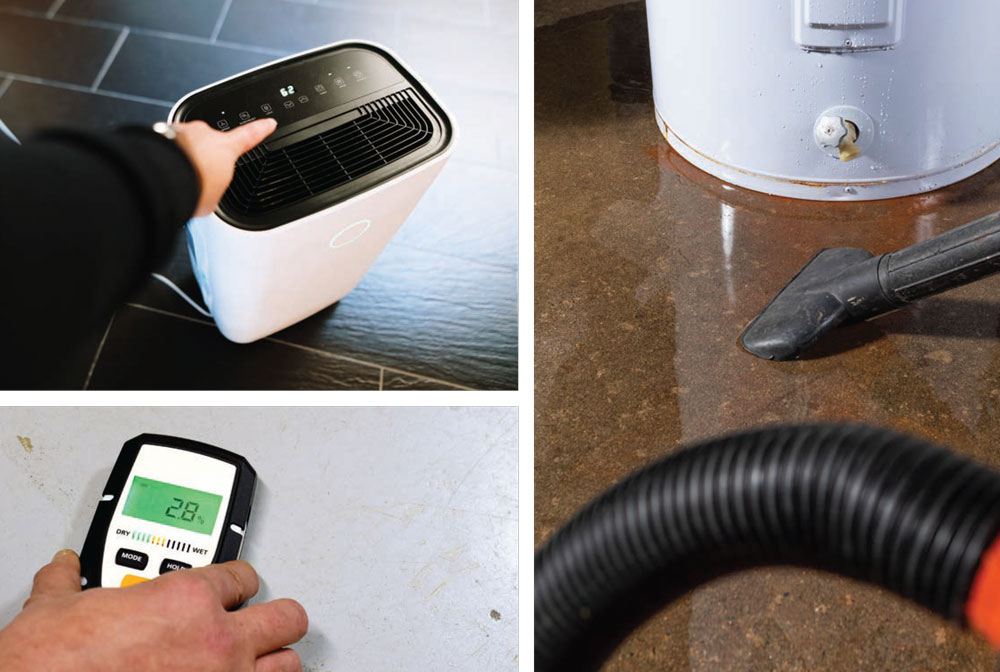Practically all homeowners shudder at the sight of the ugly gray or light brown (mildew) or black/green/red speckles (mold) that crop up in basements and closets, on outdoor furniture cushions, boat vinyl seats and padded trim. In fact, any surface that’s regularly exposed to moisture and/or is poorly ventilated is an inviting host for these fungi. Homeowners lucky enough to own waterfront property are especially susceptible.
Fungi spores arrive though open windows and doors, vents and HVAC systems. They hitchhike in on clothing, shoes, bags and even pets. Mildew starts as fine dots and migrates outward, while mold grows inward, eating into surfaces and causing significant damage.
The ugly stuff can form wherever there is moisture. Leaks in roofs and around windows and pipes soak surrounding areas and create mold nurseries. It thrives on paper, cardboard, ceiling tiles, wood, insulation, drapes and carpet. A home that’s been flooded is likely to become “mold-central” in no time.
So can anything be done to prevent mold and mildew from forming? And how does one best deal with this unsightly nuisance?
Keep it dry and airy
Low humidity and good ventilation are sworn enemies of mildew and mold. Home humidity should be kept below 50 percent whenever possible; air conditioners and dehumidifiers help significantly. Also, clean out storage areas to allow for better air circulation; piles of whatever in the back of closets invite mildew formation. Setting your HVAC fan to operate continuously, especially during warm, humid months, is a logical defense tactic.
Here are a several more recommendations from the Environmental Protection Agency (EPA):
- An inexpensive meter from a home improvement store will make monitoring your home’s humidity easy. Levels change over the course of a day so you will need to check it more than once a day during a trial period each season.
- Be sure the air in your home flows freely. Use exhaust fans that vent outside your home in the kitchen and bathroom, especially during showers. Make sure your clothes dryer vents outside your home.
- Air purifiers can help prevent the spread of mold spores. Recent HVAC units often include mold-inhibiting lights that typically require maintenance or replacement to remain effective. Have them checked during your annual HVAC tune-up visit.
- Fix any leaks in your home’s roof, walls, or plumbing so mold does not have wet areas in which to grow.
- Clean and dry out your home fully and quickly (within 24–48 hours) after any water spillage or flooding. Hiring a contractor with industrial strength vacuums, fans and dehumidifiers is a must after a major flood from weather or broken pipes.
- Add mold inhibitors, sold at paint and home improvement stores, to paints you use when building, remodeling or redecorating mold-breeding areas.
- Clean bathrooms with mold-killing products.
- Remove or replace carpets and upholstery that have been soaked and cannot be dried right away. Replace carpets in bathrooms and basements with non-absorbing alternative materials like luxury vinyl tile.
 Invest in covers for outdoor furniture to keep the rain off. Remove and turn inside out on sunny days so leaks and condensation can dry out.
Invest in covers for outdoor furniture to keep the rain off. Remove and turn inside out on sunny days so leaks and condensation can dry out.
More tips are available in the EPA’s booklet, A Brief Guide to Mold, Moisture, and Your Home found at epa.gov.
Dealing with pre-existing mold in your home
Mold can be removed from hard household surfaces with heavy duty soap or a mild bleach solution of no more than one cup of laundry bleach in a gallon of water. The Centers for Disease Control (CDC) recommends following these precautions when using bleach for mold clean-up:
- Never mix bleach with ammonia or other household cleaners, which will produce a poisonous gas.
- Always heed the manufacturer’s instructions when using bleach or any other cleaning product.
- Open windows and doors to provide fresh air.
- Wear rubber boots, rubber gloves and goggles during cleanup of affected areas.
- If you need to clean more than 10 square feet, check the EPA guide titled Mold Remediation in Schools and Commercial Buildings, which gives advice on all building types.
 Boats especially welcome mildew
Boats especially welcome mildew
While sunshine plus fresh air — critical factors in a boat’s enjoyment equation — are mildew fighters, a marine environment is heavy on moisture. Whether it’s wave spray, puddles from dripping swimmers or a dousing from a rain shower, boat seat cushions get wet on most every outing. That water seeps between seat backs and cushions, creating the perfect incubation areas for spores. Then the boat sits idle between uses, probably under some form of marginally-ventilated canvas or cover, and mildew throws a growth party!
Best advice: Wipe everything down with a towel or chamois-like absorbent cloth at the end of each outing and open hinged seats and storage compartments. For extended periods of non-use, place gel tubs (DampRid or similar) to absorb moisture and consider using an inexpensive fan and timer for a few hours of under-cover air circulation each day.
Some of the gunk that grows regardless can be treated with sprays such as Star brite®, Marine 31 and others. You might also try a “magic eraser” type sponge or search out home concoctions based on vinegar, boric acid, baking soda and hydrogen peroxide, usually cheaper than the commercial mixes. As for using bleach to kill surface mildew, be cautious: it’s a powerful chemical that can discolor some vinyl, destroy stitching and make white spots on rugs, fabrics and clothing. Many recommend NOT using bleach, though some commercial products do contain it in fairly forgiving concentrations.
In summary: Keep your home and boat clean and dry, and your battle with mold and mildew will be much easier. ✦


